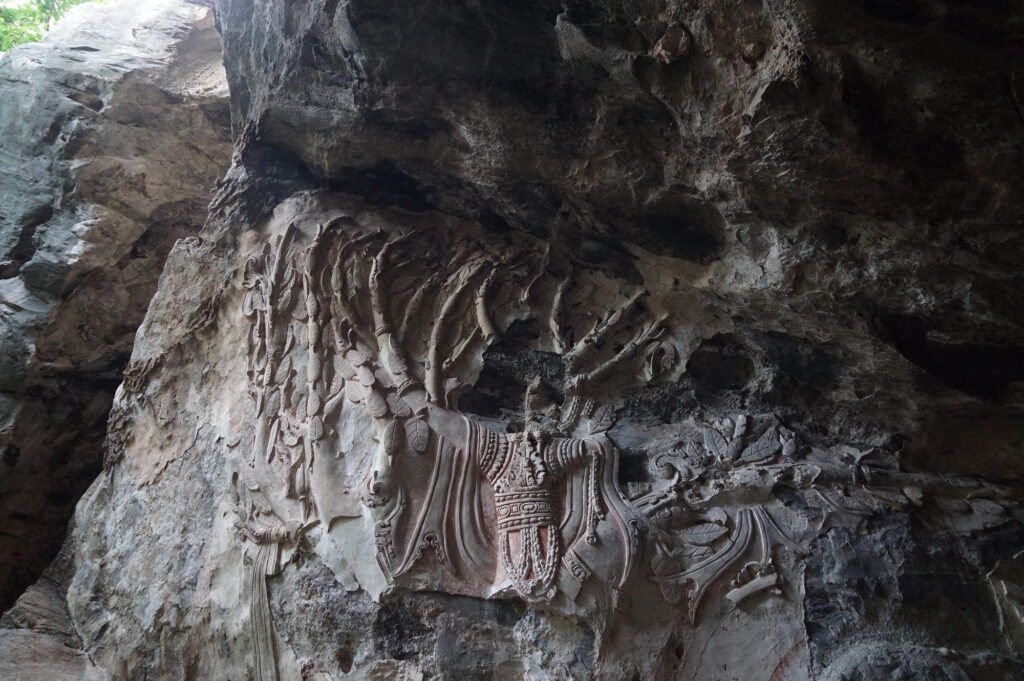Nestled eight kilometres northwest of downtown Ratchaburi, the Khao Ngu Stone Park is a hidden gem adorned with scattered caves and limestone mountains. Formerly a stone mill, it now offers visitors a chance to bask in the awe-inspiring beauty of the reservoir and relish panoramic mountaintop vistas. The lesser-known sanctuary entices small-time archaeologists and spiritual seekers to explore the timeless allure of ancient Buddhist art adorning the sacred caves.
Begin your journey at Tham Ruesi, the revered “Hermit Cave,” where the ancient Buddha relief sculpture, Phra Phuttha Chai, has adorned the stone wall since the Dvaravati Period.
Perched on a mountain slope, the Hermit Cave presents a delightful challenge, requiring a climb up a series of staircases to reach its revered mouth. Encapsulating the essence of serenity, the Buddha relief adorns the stone wall, depicting the enlightened one seated with legs hanging down. The right hand forms a graceful “Wheel of Dharma” gesture with the thumb and index fingers, while the left hand rests on the left knee. A welcoming sight, this Teaching Buddha seems to beckon visitors with a waving hand, just as it did to pilgrims, monks, and merchants during its heyday.

The origins of Phra Phuttha Chai, the Teaching Buddha, remain unknown. However, the hearsay has it that the Buddha relief was made when the Lord Buddha cast his shadow on the cave wall as he left after imparting his teachings.
The presence of Pallava script, intricate facial features, and posture hints that Phra Phuttha Chai within the Hermit Cave was sculpted around the seventh century. This period marked the spread of Buddhism from Sri Lanka and India to the Dvaravati Kingdom. Today, the cave allures diverse visitors, from weekenders and curious explorers to devoted pilgrims seeking a passage to the past.

Within the cave, you will also discover Ayutthaya Period sandstone Buddha images, including a standing Buddha relief intricately carved into the limestone wall, dating back to the same period as Phra Phuttha Chai.
Just 250 meters from the Hermit Cave lies the Fa Tho Cave. The hidden grotto is well worth the climb to admire the ancient relief sculpture of the sacred Sal tree and the serene Reclining Buddha. Though the date remains elusive, the profound message within this mysterious cave captivates all who venture forth.
In Buddhism, the Sal tree embodies the circle of life, intertwined with the birth and demise of the revered Lord Buddha. Liberation from this cycle of suffering and cruelty lies solely in enlightenment. Gently reclining on the cave wall, the Buddha exudes a serene and content expression, a poignant symbol of attaining the state of nirvana.

A short stroll from Fa Tho Cave, the Chin and Cham caves mesmerize visitors with the nation’s oldest reclining Buddha and captivating Buddhist art adorning the cave walls.
Having explored the ancient Buddha images and religious art in the caves, the park’s small yet picturesque reservoir invites you to stroll along the boardwalk and unwind. For the intrepid souls, additional staircases lead to the Khao Ngu Viewpoint, offering breathtaking vistas of the reservoir and beyond.

GETTING THERE
Ratchaburi province is conveniently located just 90 minutes’ drive west of Bangkok. This charming province boasts a rich heritage, as well as numerous museums and art galleries, making it an ideal destination for a fulfilling weekend getaway.












